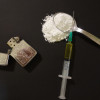The Brightest Thing in Nature
Interview with
Cambridge University Scientist Beverley Glover has discovered what she says is the brightest thing in nature; and guess what? It isn't Stephen Hawking! She explains the work to Chris Smith...
Beverley - What we found is that the fruit of a plant called Pollia condensata that lives in Africa is the brightest thing in nature. It reflects a higher percentage of the light shining on it than anything else ever recorded, including the famously bright shiny butterflies that you see out there. It's a blue-coloured fruit with speckles of pink, yellow, and green in it. It's iridescent. It changes colour as you look at it from different angles and the colour is really bright and really striking.
Chris - How did you find it?
Beverley - A colleague in the Royal Botanic Gardens at Kew was looking through their collection and she knew that I was interested in plants that use structures to generate interesting colour effects. They're not just your usual pigmentation, but more unusual or striking colours and she saw this very bright blue fruits that had been collected over 50 years ago. Even though they'd been pressed and dried, they were still as bright as when they'd been collected, so she passed them along to us to do the analysis.
Chris - And how do you know that they are the brightest thing in nature?
Beverley - Well, they may not be. They're the brightest thing measured so far in nature, which would be a fairer way to put it. So the percentage of light that they reflect back is higher than that reported for anything else that anybody has ever measured.
Chris - Do we know how they do that?
Beverley - Yes, we do. It's a very clever mechanism and interestingly, it's an example of convergent evolution because a lot of animals use a similar mechanism. If you think of bright blue butterflies or beetles then they're highly reflective because they have layers of secreted chitin on top of their wings and the layers are spaced at just the right frequency to reflect back particular wavelengths of light. The cleverness in the system is that the more layers you have, the more light you reflect back, so you get a higher percentage of reflectivity. What our fruit is doing is that every individual cell on the outer layer of the fruit has layers within its cell wall. So these are plant cells, they have cellulose cell walls and those walls are made up of layers of cellulose, and there are many, many, many layers of cellulose, and so, of course, they're able to reflect a very high amount of light back.
Chris - Why do they do this?
Beverley - We haven't done any experiments out there in the field to check this, but their distribution suggest that they're dispersed by birds. They don't pop open of their own accord so they probably need to be swallowed or to go through the bird's digestive tract for the seeds to come out. And yet, they don't provide any food reward and so, we think that it's actually a trick that nature has come up with a cunning scheme for attracting birds by being just really bright and shiny, even though there's nothing in it for them really.
Chris - Would that be birds that like shiny things, like magpies and bowerbirds that like to decorate their nest with bright things to attract females?
Beverley - That's very likely. It could also be that they just look like really bright blue juicy fruit, but you'd think a bird would learn that quite quickly. So, we think that it's more likely that it's about birds that decorate their nests and that are trying to attract females.
Chris - And given that you've worked out how the fruit does this, could we do anything similar or could we use that knowledge to produce ultra-bright things for us to use?
Beverley - Absolutely. So, it's a very setup because it's doing it with cellulose and cellulose of course is highly biodegradable, but also extremely cheap to grow because plants are basically made out of it. So, if we can figure out how the cellulose is organised in that way, we could potentially grow food colorants which are entirely nontoxic, biodegradable or colours for fabric as well. So, there's lots of potential application there.
Chris - But would they be like the Henry Ford? Would they be any colour you like as long as it's blue?
Beverley - No, not at all. The stacking frequency of the multilayers determines what colour you get. So, the fruit is actually multi-coloured because although most of the cells have their cell walls set to the frequency that generates blue, some are stacked to a slightly wider spacing and they generate yellow, or pink, or red.
Chris - Brilliant! Sorry about the pun. That was Cambridge Scientist Beverley Glover, discussing the bright blue fruit of the Pollia condensata plant. That was work she published this week in the journal PNAS.









Comments
Add a comment